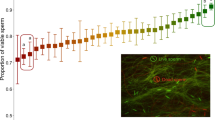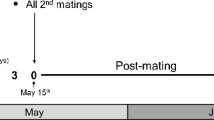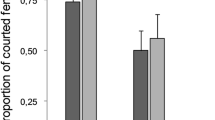Abstract
Inbreeding can have deleterious effects on individual or population fitness. To avoid fitness reduction, individuals may adopt behavioral or physiological mechanisms to reduce their investment in the production of offspring with genetically similar mates. We examined whether insemination by inbred males introduced more dead sperm than insemination by wild males by counting sperm in female Ischnura senegalensis (Rambur) sperm storage organs. If inbred males inseminated fewer or lower-quality sperm, females would avoid inferior sperm. Our results revealed three features of damselfly inbreeding: insemination failed in a larger proportion of inbred pairs than in wild pairs, inbred pairs showed significantly reduced fertility, and the numbers of live and dead sperm in an inbred female’s sperm storage organs did not differ from those in wild females. These results suggested that neither sperm quantity nor sperm quality was responsible for low fertility to a significant extent, but some kind of female quality, such as sperm usage or storing ability, was. Although inbred pairs had lower fertility, there were no significant differences between inbred and wild pairs in the total numbers of live or dead sperm. It thus seemed that female choice at the insemination stage was responsible for low fertility rather than sperm quantity or quality measured by live-to-dead ratio.




Similar content being viewed by others
References
Charlesworth B, Charlesworth D (1987) Inbreeding depression and its evolutionary consequences. Annu Rev Ecol Syst 18:237–268
Charlesworth B, Charlesworth D (1999) The genetic basis of inbreeding depression. Genet Res 74:329–340
Córdoba-Aguilar A (2006) Sperm ejection as a possible cryptic female choice mechanism in Odonata (Insecta). Physiol Entomol 31:146–153
Davey KG (1985) The female reproductive tract. In: Kerkut GA, Gilbert LI (eds) Comprehensive insect physiology, biochemistry, and pharmacology, vol 1. Pergamon Press, Oxford, pp 15–36
Dewsbury DA (1982) Ejaculate cost and male choice. Am Nat 119:601–610
Eberhard WG (1996) Female control: sexual selection by cryptic female choice. Princeton University Press, Princeton
Engqvist L, Sauer KP (2001) Strategic male mating effort and cryptic male choice in a scorpionfly. Proc R Soc B 268:729–735
Falconer DS (1989) Introduction to quantitative genetics. Longman, London
Hayashi F, Tsuchiya K (2005) Functional association between female sperm storage organs and male sperm removal organs in calopterygid damselflies. Entomol Sci 8:245–252
Hunter FM, Birkhead TR (2002) Sperm viability and sperm competition in insects. Curr Biol 12:121–123
Jennions MD, Hunt JH, Graham R, Brooks R (2004) No evidence for inbreeding avoidance through postcopulatory mechanisms in the black field cricket, Teleogryllus commodus. Evolution 58:2472–2477
Keller LF, Waller DM (2002) Inbreeding effects in wild populations. Trends Ecol Evol 17:230–241
Mack PD, Hammock BA, Promislow DEL (2002) Sperm competitive ability and genetic relatedness in Drosophila melanogaster: similarity breeds contempt. Evolution 56:1789–1795
Markow TA (1997) Assortative fertilization in Drosophila. Proc Natl Acad Sci USA 94:7756–7760
Maynard Smith J (1956) Fertility, mating behaviour and sexual selection in Drosophila subobscura. J Genet 54:261–279
Olsson M (1997) Sperm choice by females. Trends Ecol Evol 12:445–446
Pitnick S, Markow TA (1994) Male gametic strategies: sperm size, testes size, and the allocation of ejaculate among successive mates by the sperm-limited fly Drosophila pachea and its relatives. Am Nat 143:785–819
Pusey A, Wolf M (1996) Inbreeding avoidance in animals. Trends Ecol Evol 11:201–206
Reinhardt K, Siva-Jothy MT (2005) An advantage for young sperm in the house cricket Acheta domesticus. Am Nat 165:718–723
Reinhold K, Kurtz J, Engqvist L (2002) Cryptic male choice: sperm allocation strategies when female quality varies. J Evol Biol 15:201–209
Roff FA (1998) Effects of inbreeding on morphological and life history traits of the sand cricket, Gryllus firmus. Heredity 81:28–37
Sacherri IJ, Brakefield PM, Nichols RA (1996) Severe inbreeding depression and rapid fitness rebound in the butterfly Bicyclus anynana (Satyridae). Evolution 50:2000–2013
Saccheri IJ, Lloyd HD, Heyar SJ, Brakefield PM (2005) Inbreeding uncovers fundamental differences in the genetic load affecting male and female fertility in a butterfly. Proc R Soc B 272:39–46
Sharp PM (1984) The effect of inbreeding on competitive male-mating ability in Drosophila melanogaster. Genetics 106:601–612
Simmons LW (1990) Pheromonal cues for the recognition of kin by female field crickets, Gryllus bimaculatus. Anim Behav 40:192–195
Simmons LW (1991) Female choice and the relatedness of mates in the field cricket, Gryllus bimaculatus. Anim Behav 41:493–501
Simmons LW (2001) Sperm competition and its evolutionary consequences in the insects. Princeton University Press, Princeton
Siva-Jothy MT, Hooper RE (1996) Differential use of stored sperm during oviposition in the damselfly Calopteryx splendens xanthostoma (Charpentier). Behav Ecol Sociobiol 39:389–393
Snook RR, Markow TA (2002) Efficiency of gamete usage in nature: sperm storage, fertilization and polyspermy. Proc R Soc B 269:467–473
Stockley P (1999) Sperm selection and genetic incompatibility: does relatedness of mates affect male success in sperm competition? Proc R Soc B 266:1663–1669
Thornhill R (1983) Cryptic female choice and its implications in the scorpionfly Harpobittacus nigriceps. Am Nat 122:765–788
Tregenza T, Wedell N (2002) Polyandrous females avoid costs of inbreeding. Nature 415:71–73
Tsubaki Y, Yamagishi M (1991) “Longevity” of sperm within the female of the melon fly, Dacus cucurbitae (Diptera: Tephritidae), and its relevance to sperm competition. J Insect Behav 4:243–250
Twig E, Yuval B (2005) Function of multiple storage organs in female Mediterranean fruit flies (Ceratitis capitata, Diptera: Tephritidae). J Insect Physiol 51:67–74
Wallace B, Madden C (1965) Studies on inbred strains of Drosophila melanogaster. Am Nat 99:495–509
Wildt DE, Bush M, Goodrowe KL, Packer C, Pusey AE, Brown JL, Joslin P, O’Brien SJ (1987) Reproductive and genetic consequences of founding isolated lion populations. Nature 329:328–331
Wilkes A (1965) Sperm transfer and utilization by the Arrhenotolous wasp Dahlbominus fuscipennis (Zett.) (Hymenoptera: Eulophidae). Can Entom 97:647–657
Wilkes A (1966) Sperm utilization following multiple insemination in the wasp Dahlbominus fuscipennis. Can J Genet Cytol 8:451–461
Zeh JA, Zeh DW (1996) The evolution of polyandry I: intragenomic conflict and genetic incompatibility. Proc R Soc B 263:1711–1717
Zeh JA, Zeh DW (1997) The evolution of polyandry II: post-copulatory defenses against genetic incompatibility. Proc R Soc B 264:69–75
Acknowledgements
We are particularly grateful to A. Ogamino, F. Oyama, S. Karube, and S. Kawakami (Kawakami Farm) for their technical help with damselfly maintenance. We also thank K. Goka (National Institute for Environmental Studies) for advice and assistance, and P. Stockley (University of Liverpool) for valuable comments on a previous version of the manuscript.
Author information
Authors and Affiliations
Corresponding author
About this article
Cite this article
Nakahara, M., Tsubaki, Y. Sperm mortality, insemination and fertilization in the damselfly Ischnura senegalensis: comparisons between wild and inbred populations. J Ethol 26, 145–151 (2008). https://doi.org/10.1007/s10164-007-0046-z
Received:
Accepted:
Published:
Issue Date:
DOI: https://doi.org/10.1007/s10164-007-0046-z




